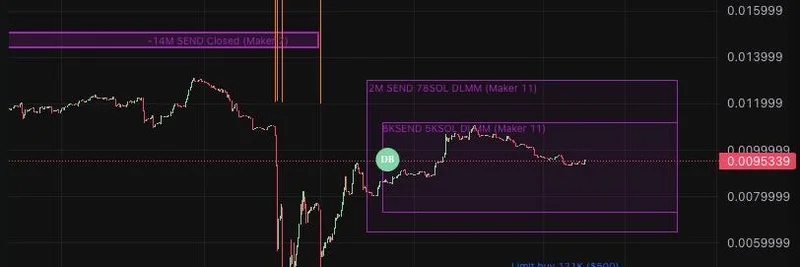In the volatile world of meme tokens on Solana, stories of whale manipulations and founder heroics are becoming all too common. Recently, a tweet from @richardkingxyz shed light on
🔍 Planning article content
- The tweet discusses a whale selling 500 SOL, crashing $SEND price, then buying back.
a dramatic episode involving $SEND, highlighting the challenges and triumphs in this fast-paced ecosystem.
It all went down on July 9-10, when a big player—known in crypto slang as a "whale" for their massive holdings—dumped 500 SOL worth of $SEND. This sudden sell-off tanked the token's price, creating panic among holders. But it wasn't just a random dump; the whale then started buying back through DCA (dollar-cost averaging), a strategy where you buy in smaller amounts over time to lower your average entry price. The goal? Scooping up more $SEND on the cheap while spooking others into selling.
Adding fuel to the fire, X (formerly Twitter) temporarily deplatformed the official Send account right around the same time. It was like a perfect storm—price crash meets social media blackout. Liquidity providers (LPs), the folks who supply funds to trading pools to enable smooth swaps, got jittery and yanked out a whopping $260K from the @MeteoraAG pool in mere minutes. MeteoraAG is a popular decentralized exchange on Solana known for its dynamic liquidity management models (DLMM), which help optimize trading efficiency.
Amid the chaos, Send's founder, @yashhsm (Yash Agarwal), kept his cool. He stepped in by depositing 300 SOL as single-sided liquidity. What does that mean? In liquidity pools, you usually provide both sides of a trading pair (like $SEND and SOL). Single-sided means adding just one asset, in this case SOL, to bolster the pool and create a price floor. This move helped absorb the panic sells, stabilized the price, and kickstarted a recovery.
Richard King, the macrodata expert behind the tweet, interviewed Yash in a live session on X Spaces (listen here). He described Yash as a "resilient founder" laser-focused on building the product, generating revenue, and mastering liquidity and token dynamics—a rare combo in the meme token space where hype often trumps fundamentals.
Key Takeaways for Meme Token Enthusiasts
This $SEND saga underscores a few critical lessons for anyone diving into Solana's meme token scene:
Whale Watching Matters: Large holders can sway prices dramatically. Tools like on-chain analytics can help spot these moves early. Check out platforms like Solana Explorer for real-time transaction tracking.
Founder Response is Crucial: In crises, a calm and proactive leader can make all the difference. Yash's quick liquidity injection not only saved the day but also rebuilt community trust.
Liquidity Dynamics 101: Understanding pools like those on MeteoraAG is key. Single-sided deposits can act as a safety net, preventing total collapses during sell-offs.
Social Media Risks: Deplatforming can amplify FUD (fear, uncertainty, doubt). Diversifying communication channels—think Telegram, Discord, or even decentralized alternatives—is a smart hedge.
For those curious about jumping in, the contract address (CA) for $SEND was shared in the thread to dodge bots—here's a snapshot:
As meme tokens continue to evolve on Solana, stories like this remind us that behind the memes and moonshots, real strategy and resilience drive long-term success. If you're building or investing in this space, keep an eye on founders like Yash—they're the ones turning turbulence into opportunity. Stay tuned to Meme Insider for more deep dives into the wild world of blockchain memes.




